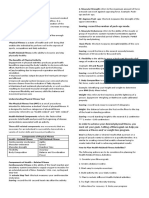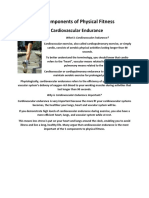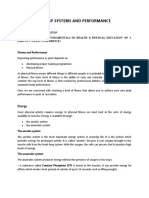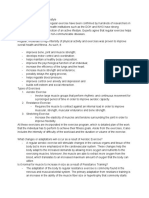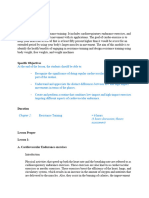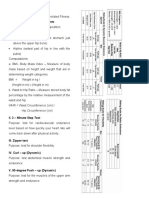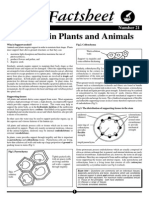Professional Documents
Culture Documents
03 Handout 1
03 Handout 1
Uploaded by
Jc GarciaOriginal Description:
Original Title
Copyright
Available Formats
Share this document
Did you find this document useful?
Is this content inappropriate?
Report this DocumentCopyright:
Available Formats
03 Handout 1
03 Handout 1
Uploaded by
Jc GarciaCopyright:
Available Formats
GE2302
HEALTH-RELATED COMPONENTS OF EXERCISE-BASED FITNESS
There are five (5) components of physical fitness: (1) body composition, (2) flexibility, (3) muscular strength,
(4) muscular endurance, and (5) cardiorespiratory endurance. A well-balanced exercise program should
include activities that address all of the health-related components of fitness. Aerobic activities develop
cardiorespiratory endurance and burn calories to aid in achieving a healthy body composition. Muscle-
strengthening activities develop muscular strength and endurance and assist with the development of
healthy body composition. Activities such as stretching and yoga also help improve flexibility.
Assessing Cardiorespiratory Endurance
Cardiorespiratory endurance is an
indication of your overall physical health
and measures how well the body performs
during long periods of exercise.
Cardiorespiratory endurance tests monitor
how well the heart, lungs, and muscles
perform during moderate to high-intensity
exercise over an extended period without
getting tired. Increasing cardiorespiratory
endurance improves oxygen uptake in the
lungs and heart and can help you sustain
physical activity for longer periods. Other
names for cardiorespiratory endurance
include cardiovascular fitness,
cardiovascular endurance, and
cardiorespiratory fitness.
Measuring your cardiorespiratory
endurance involves examining how well
your body takes in and utilizes oxygen.
When you inhale, your lungs fill up with air,
and some of the oxygen it contains passes
into the bloodstream. This oxygen-rich
blood then travels to the heart, which
circulates it around the body to the tissues
and organs that need it. The muscles require an adequate supply of oxygen and other nutrients to work
properly during high-intensity or extended periods of exercise. If the muscles do not get enough nutrients,
waste products begin to accumulate and cause fatigue. Your level of cardiorespiratory endurance can
directly affect your physical performance. Tests that measure cardiorespiratory endurance include:
• Metabolic Equivalent
A metabolic equivalent (MET) refers to the ratio between the energy expended during physical activity and
the energy expended while at rest. Finding your MET involves measuring how much oxygen your body uses
at rest.
03 Handout 1 *Property of STI
student.feedback@sti.edu Page 1 of 7
GE2302
• Maximum Oxygen Uptake
The maximum oxygen uptake (VO2 max) test
determines the maximum amount of oxygen the body is
capable of using during high-intensity activities, such as
sprinting or biking. The VO2 max test typically involves
running on a treadmill or pedaling on a stationary bike
as fast as possible. During the test, you wear a chest
strap or other body attachment that records your heart
rate and a face mask that measures oxygen
consumption.
Since cardiorespiratory endurance indicates your level
of aerobic health and physical fitness, this information
can benefit everyone, not just professional athletes.
Having a high cardiorespiratory endurance generally
means that you can perform a high-intensity exercise
for longer. People trying to lose weight may want to
focus on increasing their cardiorespiratory endurance
because doing higher-intensity aerobic activities can
help you burn more calories. Scientific research also
suggests some other potential health benefits from
having improved cardiorespiratory endurance. You can
improve your cardiorespiratory endurance through
regular exercise.
▪ A 2017 study suggests that people with higher cardiorespiratory endurance are less likely to develop
high blood pressure than those with lower cardiorespiratory endurance.
▪ In a 2015 study, researchers found a positive correlation between cardiorespiratory endurance levels
and multitasking performance among adults aged between 59 and 80 years.
▪ Improving cardiorespiratory endurance may decrease the risk of coronary heart disease and all-
cause mortality, according to a 2015 study.
▪ A 2019 study reported that resistance training, endurance training, and high-intensity interval
training led to improvements in cardiorespiratory endurance and muscular strength among adults
who were aged 40–65 years old and who were not previously physically active.
▪ A 2017 study investigated the effectiveness of a 12-week cross-circuit training program in students
who were overweight and had intellectual disabilities. The researchers found participants who
followed the training program had improved exercise endurance, muscle strength, and body mass
index.
Submaximal exercise tests are also used to measure your cardiorespiratory endurance. If you are physically
fit or an athlete, you can measure your cardiorespiratory fitness using:
03 Handout 1 *Property of STI
student.feedback@sti.edu Page 2 of 7
GE2302
▪ the Astrand treadmill test
▪ the 2.4 km run test
▪ the multistage bleep test
More sedentary people can do the Cooper 1.5-mile walk-run test. You can also do a treadmill test or
estimate your own levels comparing how fast you run to average results from races. The tests can help
provide information about how well your heart and lungs are working to get oxygen to your muscles during
exercise. The results may indicate your risk for developing heart disease or other chronic diseases. You will
include resting blood pressure and heart rate. The results can then be used to help determine the type of
exercise and weight loss programs that may be needed.
The Four (4) Fitness Zones
The first step to working out and staying fit
begins with understanding how much
energy you burn at different levels of
activity. The fitness zones are determined
by the number of calories your body uses
when it is doing certain activities, and
knowing which one fits your exercise
routine can be vital to reaching your goals
and achieving the overall fitness level you
desire. The four (4) fitness zones are low
intensity, or fat burning zone; medium
intensity, or aerobic zone; high intensity, or
anaerobic zone; and very high intensity, or
power zone.
Athletes are assigned a fitness zone based on a measure of their cardiovascular endurance. Cardiovascular
endurance is how well your heart, lungs, and circulatory system deliver oxygen to your muscles. To find out
what fitness zone you are in, you will need to first get your VO2 max from a simple breathing test. Your VO2
max is the measurement of the amount of oxygen that is delivered to your muscles per minute. The higher
your VO2 max score is, the higher the level of fitness zone you are in.
The four (4) different zones are categorized according to heart rate. Each of the four (4) zones helps you
reach a different training goal. For fat loss and weight maintenance, you may want to train in the lowest two
(2) zones; these are known as aerobic and fat-burning. The lightest zone of training is called aerobic and it is
an ideal way to burn fat, lower blood pressure, improve cholesterol levels, and strengthen your heart. These
benefits make it a great zone for someone who wants to lose weight or reduce the risk of chronic illness such
as Type 2 diabetes or heart disease. It can also be used for people looking to improve their endurance levels
or physical performance capacity.
• Fat Burning Zone
When you exercise in the fat-burning zone, you are in your aerobic or cardiovascular training range. The
majority of people who train aerobically will operate between 55-75% of their maximal heart rate. If you
want to calculate your heart rate and find out if you are in this zone, take 220 minus your age and multiply it
by 0.55 for men or 0.65 for women. This is the number that represents a percentage of the maximal heart
03 Handout 1 *Property of STI
student.feedback@sti.edu Page 3 of 7
GE2302
rate goal. For example, if your age is 40 and 220-40=180, then 180 x 0.55 = 91 beats per minute (bpm). So, a
40-year-old male should aim to exercise at a level that ranges from 55-90 bpm while his female counterpart
should shoot for 65-105 bpm.
• Cardio
In addition to your weight, understanding
the different training zones will help you
meet your fitness goals. The four (4) zones
are recovery, endurance, tempo, and
interval training.
• Stamina
To be healthy, you need to work out in all
four (4) fitness zones. To maintain your
optimal health, you should start with
aerobic exercise like walking or jogging for
30 minutes a day at least five (5) days a
week. Then, move on to lifting weights or
doing other strength training three (3) times a week for about 20 minutes. Finally, you should stretch after
each workout session and do flexibility exercises twice per week.
• Endurance
An endurance workout is anything over 60 minutes and may involve distances such as running, swimming, or
biking. These types of workouts can help you improve your fitness level by strengthening your cardiovascular
system, which is necessary for heart health. They also boost your immune system due to an increase in
oxygen intake and release of endorphins, which are feel-good hormones that provide a sense of euphoria.
The Skill Components of Physical Fitness
Fitness is a condition in which an individual has sufficient energy to avoid fatigue and enjoy life. Physical
fitness is divided into six (6) skill-related components. Skill- or performance-related fitness involves skills that
will enhance your performance in athletic or sports events. Health-related fitness involves skills that enable
you to become and stay physically healthy. There are agility, balance, coordination, speed, power, and
reaction time. Skilled athletes typically excel in all six (6) areas.
• Agility
It is the ability to change and control the direction and position of the body while maintaining a constant,
rapid motion. For example, changing directions to hit a tennis ball or badminton shuttle cock.
• Balance/ Coordination
It is the ability to control or stabilize the body when you are standing still or moving. For example, in-line
skating or skateboarding. It is also the ability to use the senses together with body parts during movement.
For example, dribbling a basketball or riding a mountain bike. Using hands and eyes together is called hand-
eye coordination.
03 Handout 1 *Property of STI
student.feedback@sti.edu Page 4 of 7
GE2302
• Accuracy
Accuracy is the ability of the body to direct
the muscles and force them towards a
particular direction, which helps to
enhance performances in jumping and
throwing events like the long jump, high
jump, and javelin throw.
• Speed
It is the ability to move your body or parts
of your body swiftly. Many sports rely on
speed to gain an advantage over your
opponents. For example, a basketball
player making a fast break to perform a
layup, a tennis player moving forward to get to a drop shot, or a football player out running the defense to
receive a pass.
• Power
It is the ability to move the body parts swiftly while applying the maximum force of the muscles. Power is a
combination of both speed and muscular strength. For example, fullbacks in football muscle their way
through other players and speed to advance the ball, and volleyball players get up to the net and lift their
bodies high into the air to block or spike.
• Reaction Time
It is the ability to reach or respond quickly to what you hear, see, or feel. For example, an athlete quickly
coming off the blocks early in a swimming or track relay, or stealing a base in baseball.
The Benefits of Exercise in the Aging Process
Everyone knows that exercise is good for you. But it is not just beneficial for the young, healthy, and already
fit. Countless studies prove the important health benefits associated with exercise, and it becomes more
important as you age. Regular physical activity and exercise for seniors help improve mental and physical
health, both of which will help you maintain your independence as you age. It is also one of the best
defenses against the toughest aspects of aging. Exercise not only improves heart and lung health, but
research shows that even modest physical activity is good for the brain, bones, muscles, and mood.
Numerous studies have found that lifelong exercise may keep people healthier for longer; delay the onset of
chronic conditions or diseases; stave off cognitive decline; reduce the risk of falls; alleviate depression,
stress, and anxiety; and may even help people live longer. Here are just some of the ways research shows
the benefits of exercise in the aging process.
• Muscle Strength
As people age, they lose muscle mass and strength, a condition is known as sarcopenia. Scientists say
resistance training is one of the best ways to help slow that decline. It not only maintains muscle strength
and power (what you will need while opening a jar or pushing a heavy door), but it makes everyday activities
like cooking, cleaning, and climbing stairs less difficult. It can also help reduce disease susceptibility, improve
brain health and mood, and help you maintain independence longer. Researchers found that resistance
03 Handout 1 *Property of STI
student.feedback@sti.edu Page 5 of 7
GE2302
training is safe and effective for older adults, with rates of injuries extremely low and similar across all ages
and intensities.
• Bone Density
To keep bones strong, the body breaks down old bone and replaces it with new bone tissue—but around age
30, bone mass stops increasing. In your 40s and 50s, you slowly start losing more bone than you make.
Exercise can help increase bone density when you are younger and stave off osteoporosis, a disease that
weakens bone and increases the risk of breaks as you age. Almost half of all adults 50 and older are at risk of
breaking a bone due to osteoporosis. But that does not mean that older people are powerless; doing weight-
bearing exercises throughout life helps increase bone mass and strength.
Since osteoporosis affects women more often than men, activities like walking or aerobics are especially
important after menopause. While older people cannot gain more bone mass, physical activity can help
prevent bone loss. Lower-impact activities like cycling, yoga, and swimming are not enough to affect bone
loss, but when combined with weight-bearing exercises, they can help improve balance and reduce the risk
of falls and fractures.
• Telomere Length
Telomeres are the caps on the ends of DNA strands, similar to the caps on shoelaces. Their length decreases
with aging, and this contributes to cell senescence, meaning the cells can no longer divide. Telomere length
is connected to certain chronic conditions, especially high blood pressure, stroke, and heart disease. Several
studies have found that higher levels of physical activity are related to longer telomere lengths in some
people, compared to those who are sedentary. This seems to be especially true in older people. However, it
is still not clear whether that relationship is causal, and multiple processes likely affect telomere length. But
in general, longer telomeres are believed to be a plus for reducing the risk of age-related diseases.
• Improved Cognitive Function
Your ability to shift quickly between tasks, plan an activity and ignore irrelevant information are all signs of
good cognitive function. Physical activity is now seen as one of the most promising methods for improving
cognition throughout life and reducing the risk of age-related cognitive decline. While researchers cannot yet
say for sure that exercise can prevent dementia, studies show that more physical activity is linked to reduced
risk of dementia, including Alzheimer’s disease. Regular physical activity and fine-tuned motor skills benefit
cognitive function. Countless studies suggest a lower risk of dementia for physically active individuals,
regardless of when they begin a routine.
• Disease Prevention
Studies have shown that maintaining regular physical activity can help prevent many common diseases, such
as heart disease and diabetes. Exercise improves overall immune function, which is important for seniors as
their immune systems are often compromised. Even light exercise, such as walking, can be a powerful tool
for preventable disease management.
• Improved Mental Health
The mental health benefits of exercise are nearly endless. Exercise produces endorphins (the “feel good”
hormone), which act as a stress reliever and leaves you feeling happy and satisfied. In addition, exercise has
been linked to improving sleep, which is especially important for older adults who often suffer from
insomnia and disrupted sleep patterns.
03 Handout 1 *Property of STI
student.feedback@sti.edu Page 6 of 7
GE2302
• Decreased Risks of Falls
Older adults are at a higher risk of falls, which can prove to be potentially disastrous for maintaining
independence. Exercise improves strength and flexibility, which also help improve balance and coordination,
reducing the risk of falls. Seniors take much longer to recover from falls, so anything that helps avoid them in
the first place is critical.
• Social Engagement
Whether you join a walking group, go to group fitness classes, or visit a gardening club, exercise can be made
into a fun social event. Maintaining strong social ties is important for aging adults to feel a sense of purpose
and avoid feelings of loneliness or depression. Above all, the key is to find a form of exercise you love, and it
will never feel like a chore again.
As scientists continue to research the effects of exercise, they are finding all kinds of exciting benefits. There
is still a lot we do not know about how exercise affects the aging process, but what we do know is this:
moving your body regularly—five (5) times per week, for at least 30 minutes daily—is better than moving
less often. Exercise is cumulative; you do not have to do it all at once (and of course, check with your health
provider/ medical practitioner before starting any new activity). And a combination of aerobic and resistance
exercises seems to provide the most benefits for most people.
In conclusion, exercise-based fitness is good for you; it is just a matter of making it a priority and habit in
your daily life. In the aging population, exercise has been shown to prevent disease, lower the risk of falls,
improve mental health and well-being, strengthen social ties, and improve cognitive function. Regardless of
your age, incorporate exercise into your life. Best of all, it is never too late to start.
References:
Delavier, F. (2023). Strength training anatomy (4th edition). Human Kinetics.
Murray R. & Kenney W. L. (2021). Practical guide to exercise physiology: the science of exercise training and
performance nutrition (2nd edition). Human Kinetics.
Pate, R., Oria, M., & Pillsbury, L., Youth, in, Food and Nutrition Board, & Institute of Medicine. (2012, December
10). Health-Related Fitness Measures for Youth: Cardiorespiratory Endurance. Nih.gov; National Academies
Press (US). https://www.ncbi.nlm.nih.gov/books/NBK241309/
“The Ultimate Guide to Cardio Training- Why Zone Two Matters. Whealth. Invest in Your Health.
https://spreadwhealth.com/whealth-blog/ultimate-guide-to-cardio-training. Accessed 13 Apr. 2023.
Williams, L. (2019). “Improve Athletic Performance with 6 Skill-Related Fitness Components.” Verywell Fit.
https://www.verywellfit.com/skill-related-fitness-components-4155209
03 Handout 1 *Property of STI
student.feedback@sti.edu Page 7 of 7
You might also like
- Proceedings of The 16th Italian Association of Equine Veterinarians CongressDocument6 pagesProceedings of The 16th Italian Association of Equine Veterinarians CongressCabinet VeterinarNo ratings yet
- Team Sports - Games: Portfolio Prelim - FinalsDocument33 pagesTeam Sports - Games: Portfolio Prelim - FinalsLydia ElaNo ratings yet
- Exercise-Based Fitness Activities Topic or Lesson 9: Sub-Topic/S:: Definition of Cardiorespiratory Fitness: Importance of Cardiorespiratory FitnessDocument4 pagesExercise-Based Fitness Activities Topic or Lesson 9: Sub-Topic/S:: Definition of Cardiorespiratory Fitness: Importance of Cardiorespiratory FitnesskennethquenanoNo ratings yet
- Fitness Exercises: Cardiorespiratory and Muscular Fitness: ObjectivesDocument16 pagesFitness Exercises: Cardiorespiratory and Muscular Fitness: ObjectivesArabella Grace AcibarNo ratings yet
- Physical Fitness TestDocument1 pagePhysical Fitness TestGiessen Fran RamosNo ratings yet
- Cardiorespiratory Endurance: in This Chapter Student Web ResourcesDocument9 pagesCardiorespiratory Endurance: in This Chapter Student Web ResourcesFRANCO PANUGALINGNo ratings yet
- Cardiorespiratory Endurance: in This Chapter Student Web ResourcesDocument9 pagesCardiorespiratory Endurance: in This Chapter Student Web ResourcesChaye DomingoNo ratings yet
- FitnessDocument53 pagesFitnessMATHEW ANGELO GAMBOANo ratings yet
- Pe 11 Lecture 1ST SemDocument12 pagesPe 11 Lecture 1ST SemBawat PiyesaNo ratings yet
- Five Components of Physical FitnessDocument5 pagesFive Components of Physical FitnessBenj MendozaNo ratings yet
- Aerobic and Anaerobic Energy SystemsDocument5 pagesAerobic and Anaerobic Energy SystemsShanta MathaiNo ratings yet
- Physical Education and HealthDocument8 pagesPhysical Education and Healthmary rose mendozaNo ratings yet
- Cardiorespirato Ry Endurance and FlexibilityDocument11 pagesCardiorespirato Ry Endurance and FlexibilityYNAFER DE LA CRUZNo ratings yet
- Session 1 (Components of Fitness)Document31 pagesSession 1 (Components of Fitness)darvelasco05No ratings yet
- PE11-UNIT 1-Lesson-1Document18 pagesPE11-UNIT 1-Lesson-1SherilynAlvarezNo ratings yet
- Pe 3Document10 pagesPe 3Princess SibugNo ratings yet
- Physical Fitness Short Note (SPSC 1011) Unit One 1. 1. Concepts of Physical Fitness1 1.1. 1. Meanings and Definitions of Physical FitnessDocument62 pagesPhysical Fitness Short Note (SPSC 1011) Unit One 1. 1. Concepts of Physical Fitness1 1.1. 1. Meanings and Definitions of Physical Fitnesseyob astatkeNo ratings yet
- Physical Fitness and PPFTDocument34 pagesPhysical Fitness and PPFTGlenn Durano RantayoNo ratings yet
- Peh 11 IshrmDocument24 pagesPeh 11 IshrmAlthea Yazhua D bautistaNo ratings yet
- FITT - The Formula For FitnessDocument2 pagesFITT - The Formula For FitnessLil MotionNo ratings yet
- GPE2 Module3Document34 pagesGPE2 Module3Ana Llemit MionesNo ratings yet
- Module 3: How To Assess and Monitor Your Physical Fitness Components?Document33 pagesModule 3: How To Assess and Monitor Your Physical Fitness Components?John Mark SalardaNo ratings yet
- Week 2Document2 pagesWeek 2Francyne Jhayda EspañolaNo ratings yet
- Physical Education Notes For MidtermDocument15 pagesPhysical Education Notes For Midtermjeliel hyacinthNo ratings yet
- Unit One Concepts of Physical FitnessDocument9 pagesUnit One Concepts of Physical FitnessYoseph DefaruNo ratings yet
- Chapter 1 PE2Document17 pagesChapter 1 PE2Jessel CabasalNo ratings yet
- Lesson 2Document15 pagesLesson 2Arianne Jewel ContrillasNo ratings yet
- Cardiorespiratory EnduranceDocument7 pagesCardiorespiratory EnduranceAlthea SorianoNo ratings yet
- Report Sa PeDocument16 pagesReport Sa Pekuma kumaNo ratings yet
- What Is Endurance?: Parameters of Comparison Endurance StaminaDocument3 pagesWhat Is Endurance?: Parameters of Comparison Endurance StaminaYangNo ratings yet
- General Motor FitnessDocument25 pagesGeneral Motor FitnessSahil ChauhanNo ratings yet
- Physical Fitness and SwimmingDocument65 pagesPhysical Fitness and SwimmingnathanielNo ratings yet
- Respiratory SystemDocument7 pagesRespiratory Systemjohn dave andinoNo ratings yet
- Hpe Reading Note G - 10Document12 pagesHpe Reading Note G - 10badasaamadinNo ratings yet
- Body Composition: Body Fat and Storage Body FatDocument6 pagesBody Composition: Body Fat and Storage Body FatJoseph Ian LoyolaNo ratings yet
- PE HandoutDocument6 pagesPE HandoutchrisyymalateNo ratings yet
- Rozi WarganegaraDocument9 pagesRozi WarganegaraFuad KoasNo ratings yet
- PHYSICAL-EDUCATION-1 Handouts 2022Document3 pagesPHYSICAL-EDUCATION-1 Handouts 2022Russel Cyrus SantiagoNo ratings yet
- Cardiovascular Fitness Activity MiDocument2 pagesCardiovascular Fitness Activity MiDESALEGN SETUNo ratings yet
- Unit IIDocument23 pagesUnit IIRinoa GuntalilibNo ratings yet
- Physical Education Exercises - by SlidesgoDocument12 pagesPhysical Education Exercises - by SlidesgoEdward Handag Mascual Jr.No ratings yet
- Cardiorespiratory and Muscoskeletal FitnessDocument15 pagesCardiorespiratory and Muscoskeletal FitnessLeslie PerezNo ratings yet
- ExerciseDocument6 pagesExerciseroidonato12No ratings yet
- Grade 11 Physical Education ModuleDocument19 pagesGrade 11 Physical Education ModuleCherrylyn DonayreNo ratings yet
- Pathfit 2 Module 1Document26 pagesPathfit 2 Module 1Kate Barbara Anne Simoy-EscosiaNo ratings yet
- Physical Fitness Unit OneDocument26 pagesPhysical Fitness Unit Onebesedegefub9131No ratings yet
- Path Fit - 2 Fitness Training Corse Title: Fitness Training (Exercise - Based Course) Course DescriptionDocument5 pagesPath Fit - 2 Fitness Training Corse Title: Fitness Training (Exercise - Based Course) Course DescriptionJulie Mae Cagalawan75% (4)
- What Is Aerobic Exercise?Document2 pagesWhat Is Aerobic Exercise?Diana BernalNo ratings yet
- Health-Related Fitness ComponentsDocument26 pagesHealth-Related Fitness ComponentsJessa Nasalita100% (2)
- Pathfit ReviewerDocument9 pagesPathfit ReviewerAis WallensteinNo ratings yet
- Pe 1 ReviewerDocument17 pagesPe 1 ReviewerJoferlyn Mai Marabillo VillarNo ratings yet
- Training For Cardiopulmonary and Cardiovascular EnduranceDocument32 pagesTraining For Cardiopulmonary and Cardiovascular Enduranceluxmee bhattaraiNo ratings yet
- Pe and H1Document7 pagesPe and H1Toni CruzNo ratings yet
- Peh 1 (Notes)Document14 pagesPeh 1 (Notes)Louise Bea ValbuenaNo ratings yet
- What Is Physical FitnessDocument6 pagesWhat Is Physical FitnessJhen BarnardNo ratings yet
- PEGROUP1Document8 pagesPEGROUP1ghingxloffeeNo ratings yet
- PATHFIT 1 PRELIMS EditDocument25 pagesPATHFIT 1 PRELIMS Editvincent boralNo ratings yet
- Moch. Dandy Firmansyah Public SpeakingDocument3 pagesMoch. Dandy Firmansyah Public SpeakingdandyyfirmansyahNo ratings yet
- HOPE NotesDocument6 pagesHOPE NotesCarmen De HittaNo ratings yet
- Pathfit Health and FitnessDocument4 pagesPathfit Health and FitnessRhea Mae PerezNo ratings yet
- COMPRE2Document13 pagesCOMPRE2Rodrigo SeriozaNo ratings yet
- Biomechanics of Bone-Fracture Fixation by Stiffness-Graded Plates in Comparison With Stainless-Steel PlatesDocument16 pagesBiomechanics of Bone-Fracture Fixation by Stiffness-Graded Plates in Comparison With Stainless-Steel PlatesRENATO ALONSO PACHECO ROSALESNo ratings yet
- Connective Tissue by Dr. Gironella PDFDocument3 pagesConnective Tissue by Dr. Gironella PDFFatima RadeenaNo ratings yet
- Orthopedic InjuriesDocument27 pagesOrthopedic InjuriesvikramNo ratings yet
- Week 11-2Document60 pagesWeek 11-2Wong ChocolateNo ratings yet
- Development of PeriodontiumDocument24 pagesDevelopment of Periodontiumpalak sharma100% (1)
- Barrier Membranes: More Than The Barrier Effect?Document39 pagesBarrier Membranes: More Than The Barrier Effect?Alka Rose JamesNo ratings yet
- Anatomy and Healing Process of Paediatric Bone - Dato DR Zulkiflee OsmanDocument56 pagesAnatomy and Healing Process of Paediatric Bone - Dato DR Zulkiflee OsmanMuhammad Naqiuddin JalaluddinNo ratings yet
- Dental Implants - An Evolving Discipline - An Issue of Oral and Maxillofacial Clinics of North America (The Clinics - Dentistry) (UnitedVRG)Document182 pagesDental Implants - An Evolving Discipline - An Issue of Oral and Maxillofacial Clinics of North America (The Clinics - Dentistry) (UnitedVRG)George TătarNo ratings yet
- Nutrilite Lifestyle & Speciality RangeDocument58 pagesNutrilite Lifestyle & Speciality Rangeapi-3721443100% (2)
- Case Study Final FractureDocument27 pagesCase Study Final Fracture3amabelle arevaloNo ratings yet
- Nasal TraumaDocument5 pagesNasal TraumaRae Marie AquinoNo ratings yet
- Bones OssificationDocument9 pagesBones OssificationNaveed AfridiNo ratings yet
- "Approwed" On The Meeting of The Department of Surgical Dentistry and Maxillofacial SurgeryDocument10 pages"Approwed" On The Meeting of The Department of Surgical Dentistry and Maxillofacial SurgeryMadeline WanhartNo ratings yet
- Reviews: Fracture Healing: Mechanisms and InterventionsDocument10 pagesReviews: Fracture Healing: Mechanisms and InterventionsFatrika DewiNo ratings yet
- Chapter 2.2-2.3Document15 pagesChapter 2.2-2.3Gerard Bio100% (2)
- Support in Plants and AnimalsDocument2 pagesSupport in Plants and Animalslastjoe71100% (1)
- Theraputic UltrasoundDocument64 pagesTheraputic UltrasoundRoshni KhanNo ratings yet
- Pharmacotherapy 10thDocument131 pagesPharmacotherapy 10thMuhamed Arsalan100% (3)
- Science English Medium Question Paper (RR - Unrevised) Karnataka 10th Board Exam March-April 2019Document12 pagesScience English Medium Question Paper (RR - Unrevised) Karnataka 10th Board Exam March-April 2019fuvcszcchdtjNo ratings yet
- Osteocondroma & OsteochondromatosisDocument24 pagesOsteocondroma & OsteochondromatosisrazalihamidNo ratings yet
- Support in Complete DentureDocument30 pagesSupport in Complete DentureSahana Rangarajan100% (2)
- First Listening Test 7Document3 pagesFirst Listening Test 7Carles Sastre PérezNo ratings yet
- Skeleton Lesson Plan2Document4 pagesSkeleton Lesson Plan2Shamim KhaliqNo ratings yet
- Aureus. It Can Be Either Acute or ChronicDocument7 pagesAureus. It Can Be Either Acute or ChronicfortunelobsterNo ratings yet
- SMF Orthopaedi Dan Traumatologi RSU DR Saiful Anwar Malang: Thomas Erwin C J HuwaeDocument58 pagesSMF Orthopaedi Dan Traumatologi RSU DR Saiful Anwar Malang: Thomas Erwin C J Huwaeyulia manaweanNo ratings yet
- Medtronic - Compact CornerstoneDocument10 pagesMedtronic - Compact CornerstoneruiduartNo ratings yet
- Injuries To The Lumbosacral PlexusDocument8 pagesInjuries To The Lumbosacral PlexusKhriz Ann C ÜNo ratings yet
- Report Gisenyi DHDocument17 pagesReport Gisenyi DHjean uwakijijweNo ratings yet




